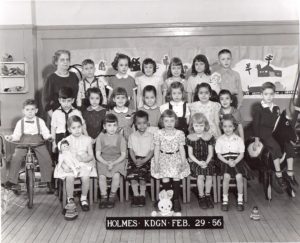
Entering kindergarten for an immigrant child in 1955 wasn’t simple or easy, especially when her parents brought their regional differences with them to America.
My mother, Eugenia Pagonis, arrived from war-torn Greece in the winter of 1947. Her siblings, who had relocated to Pittsburgh PA, during the Depression, had pre-arranged a marriage contract for her with a Greek Cypriot.
Eugenia Pagonis married Andrew Savvas Constantinides on March 7, 1948 at St. Nicholas Greek Orthodox Church in Pittsburgh.
One custom my parents brought with them declared that the firstborn child was to be named after one of the father’s parents.
So I was to be named Myrofora after my paternal grandmother. Myrofora is a Greek Cypriot name and is not common in other parts of Greece.
My maternal aunts and uncles didn’t like Myrofora, nor did they like the English-language version of my name, Myra. They wanted something else –whatever that might be.
Dad insisted on tradition. So I was alternately Myra or Myrofora for the first five years of my life.
I entered kindergarten in September, 1955 and my father had to decide what my American name was going to be. It was certain that I was going to be made fun of if I was to be called Myrofora.
Most first- and second generation immigrant kids wanted to be as American as possible. I was no different.
No one liked the name, but Dad decided that Meriam was the best alternative translation for Myrofora.
On the first day of kindergarten, he told the teacher my American name. She was an older woman who, it turns out, was hard of hearing. She recorded my name as Marion. Dad didn’t pay attention until later, but by then it was too late to change it again.
In the end, neither my parents not my aunts and uncles named me. My kindergarten teacher did!
It wasn’t until third grade that Dad noticed that my last name was also misspelled. He marched to Holmes Elementary School and demanded a correction. He had had enough.
What’s in a name, anyway?
Plenty! I’ve always hated the “o” in Marion!
Marion Constantinides
Good Old Days
Volume 4, No. 4
July/August 2015






